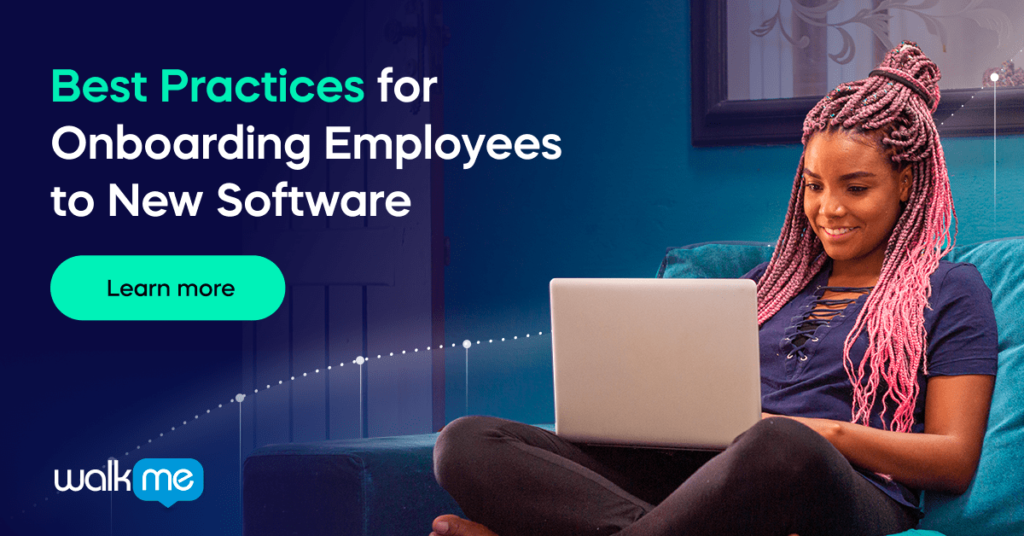What should you know when onboarding employees to a new software? The idea is that you want this user to adopt the new software and continue to engage with it – that last part is often the hardest to tackle. However, there are some things you can do to increase both user satisfaction and long-term use or retention. In this article, you will learn the importance of onboarding, the benefits of good onboarding, user onboarding best practices to follow, some mistakes to avoid, and more.
Definitions: onboarding vs. adoption
Before we go any further, let’s clarify what we mean by onboarding and how it’s different from adoption.
Here are some quick definitions to get started:
A process by which a new person, product, or tool is introduced and integrated.
Integrating software into the daily workflows of new employees or users.
The introduction and integration of employees into the workplace.
Implementation and integration of new software, including onboarding.
The digital components in a work environment, including the tools, workflows, and so on.
Digitally driven organizational changes that leverage new technology to transform a company’s operations and customer service.
Employs software to streamline the digital workplace and maximize software ROI, utilization, efficiency, and productivity.
First impressions last
Onboarding’s importance lies in that it is often the beginning of a relationship between a user and a particular technology. And, as we know from the physical world, first impressions matter. If an employee detests a new system (whether they are required to use it or not) or is onboarded incorrectly from the start, their engagement levels with that software system will likely be minimal at best – and it’ll end up costing you.
Take these statistics for example:
- A lack of technology is blamed by 36% of HR professionals for their inability to automate and organize onboarding programs (Businesswire, 2018).
- The likelihood of an employee staying for three years increases by 69% when they participate in a structured onboarding program (ClickBoarding, 2020).
- Businesses that offer formal onboarding training are estimated to retain 50% of their employees (Harvard Business Review, 2018).
- Employees who have a poor onboarding experience resign from their companies approximately 10% of the time (Business News Daily, 2020).
Benefits of good onboarding
Good onboarding can not only gain you significantly more employees, it can gain you loyal employees. That means promoters – people who will essentially advertise for you. That’s because people love to talk about their good experiences. But, be warned, the same goes for bad experiences.
If someone has a terrible time doing anything, they will tell someone about it, whether it’s a colleague, friend, family member, or even their dog. So, if your goal is to retain loyal employees that love your company and will even act as advocates for you, onboarding is not a step to take lightly.
Common onboarding mistakes
While the range of mistakes you can make in planning an onboarding process is almost endless, these are some of the most common (and, perhaps, most detrimental) to be mindful of:
Not understanding that onboarding is ongoing
Onboarding is not just a sign-up page, a welcome email, a virtual company tour, and “good luck!”. It’s an ongoing process that requires nurturing, education, and guidance, not to mention support. There aren’t many things more frustrating than finishing an introductory training video and finding that you have no further instruction beyond an external help center or an unapproachable colleague.
Failing to set expectations
What often disappoints people in new jobs (and life in general) is a gap between expectation and reality. To avoid this, be upfront with your new hires. Let them know what they can expect from their role, what is required from them, where they can find support, and so on. In the absence of this, they will make assumptions based on who-knows-what.
Having hard-to-use or missing support options
Have you ever started a new job, needed help, and couldn’t find it? If so, then you know it can be disappointing at best and disheartening at worst. It’s crucial to make support options visible, accessible, and user-friendly to ensure a smooth hiring experience.
Not measuring or monitoring
It’s quite common that users will get stuck on one or multiple stages of an onboarding journey. However, if you don’t know where, you have no chance of fixing it. Monitoring and measuring the user journey can make a huge difference to your success rate, since it gives you the flexibility to make changes where needed. Tweak by tweak, the employee experience can be truly optimized for success.
Software onboarding best practices
Design a user journey
The first step to mapping out your desired user journey is knowing thy employee. This should include personas, needs, ambitions, and anything else that will help you resonate with them. Once that’s clear, design the user journey in a way that is clear, helpful, and delivers value.
Welcome & set expectations
Beginning the employee journey with a warm welcome and setting expectations is a great way to ensure a smooth experience. Negative surprises will only steal from a great first impression.
Provide a product tour + more
Concise but detailed walkthroughs can be the perfect way to acquaint new hires with new software. Like this, you can take them step by step, hand-in-hand through the user journey to remove any confusion or frustration. This is your opportunity to explain all the important details, including where to go for support and how to use critical software functions.
Offer clear value
By the time the user has finished the initial set-up process, they should have no further questions as to what they need to do and where they need to do it. Naturally, they may still have questions about how they should be doing certain processes, but that’s expected. If you find there is still room for improvement after doing a test walkthrough yourself, take the time to smooth out the edges before rolling it out.
Be a guide
Beyond the help resources and tour, what other guidance do you offer your new employees? A great way to add an extra layer of support is to include pop-ups and clickable bubbles that provide users with on-the-go guidance. Having these as options can make an incredibly seamless user experience, since they won’t have to exit software or open a new window to find the help they need.
Monitor struggle-points and adjust
Having visibility over your user journey is the best way to optimize your employee experience. If you can see where users are getting stuck, you can make the necessary changes to avoid it. Let’s say you notice a drop off on a particular form handler or process often, you investigate it, and find that there is a bug that is rejecting all email addresses, whether typed correctly or not. You have immediate insight into what’s impeding user signup and you can deploy your team to fix it in minutes, not hours or days. Employee productivity monitoring capabilities such as the UI intelligence offered by Walkme is truly game changing.
Optimize for mobile
Mobile phones now account for almost 55 percent of all our online time, according to GWI’s latest research (We Are Social, 2022). However, you didn’t need to know that statistic to know how prevalent mobile use is now, did you? What this means is that mobile optimization is no longer a nice addition to your offering – it’s a requirement. In absence of this, you are bound to lose users quickly and forever.
Gather employee feedback
In any business, feedback is an incredibly important and valuable resource, and it’s not to be taken lightly. In order to make it truly frictionless, you can build it into existing processes and simply make it part of the journey. Still, for it to be effective, you need to turn that feedback into action.
Guiding questions to fall back on
So far, we have provided a decent amount of information to get you started on your journey of onboarding new employees to your team. However, if you are in doubt of your progress at any point, here are some important, guiding questions to keep in mind:
Have you kept the interface and employee journey simple?
Is your interface and user journey simple and logical or does any part of it cause hesitation or confusion? If any of the latter is remotely true, make the necessary changes.
Has your onboarding process remained relevant to user goals?
Have you kept the range of predetermined user goals in mind during the creation of your user journey? Or have these goals gotten lost in the process?
Have you provided sufficient support options?
At each and every stage of your user journey, is it clear where users can turn to for support? Do they need to go digging for a help button? Does clicking on said help button make it easy or difficult to return to what they were doing?
Is your value proposition crystal clear?
Is it 100% clear from the get-go what the exact type of value your software offers your user? Is your copy clear? Your story straight?
Is your user journey optimized?
If your user needs to access your software from mobile, how will it look? If there is an option to export documents, are there a range of formats to choose from? Are your images so large that they take more than an instant to load?

Conclusion
Hopefully, this article has provided you with the confidence to go forth and create an incredible employee experience using these onboarding best practices. We have covered the beneficial impact of good onboarding, common mistakes to avoid, best practices, and beyond. Whether you are planning to set up your onboarding manually or with WalkMe’s digital adoption platform, these tips will help you on your way.

